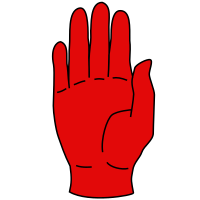Clan Lamont
The clan is said to descend from Ánrothán Ua Néill, an Irish prince of the O'Neill dynasty, and through him Niall Noigíallach, High King of Ireland.
Based on oral traditions, this invasion into Scottish territory was led by the three sons of Erc, the King of Dal Riata.
From Anrothan's line came a prominent lord named Aodha Alainn O'Neil, who had three sons: Gillachrist, Neill, and Dunslebhe.
His descendants, the early chiefs of the clan, were described as "The Great MacLamont of all Cowal" (Scottish Gaelic: Mac Laomain mor Chomhail uile).
[8] During the Wars of Scottish Independence, Sir John Lamont, Laumon's grandson and the Chief of the clan, sided with the MacDougall's of Lorne against Robert the Bruce.
In 1371, Robert II gave the Lamont hereditary seat at Dunoon to Bruce supporter Sir Colin Campbell, Black Knight of Loch Awe.
The incident was passed along to the King, who punished Clan Lamont by rescinding nearly eight square miles of their lands in Strath Echaig and granting them to the Campbells.
[9] As a result of this increasing lordship of Lamont lands, Clan Campbell became even more bold in asserting their power over Argyll, and more specifically, Cowal.
In 1472, Clan Campbell received charter for the lands around Dunoon, and they proceeded to turn the castle into their main seat.
[9] Although the Campbell/Lamont alliance failed to stop the English force, the fighting gave the Earl of Lennox enough time to escort Mary to Stirling Castle and save the House of Stuart.
[7] After the two men had made camp at nightfall they eventually became embroiled in a quarrel at the end of which Lamont grabbed his dirk and MacGregor was mortally wounded.
[7][10] Later, while it was still dark, the chief had Lamont personally conducted to Dunderave on Loch Fyne and provided him with a boat and oars.
[7] The old MacGregor lived with Lamont for years until his death, and was buried in honour in the graveyard at the chapel of St. Mary on the farm of Toward-an-Uilt.
In 1634, Sir James represented the Barons of Argyll in Parliament, although two years later, he was discovered plotting for the Royalist cause with other clan chiefs: Macdonald of Sleat, Macleod of Dunvegan, Maclean of Duart, Stuart of Bute, and Stewart of Ardgowan.
Once the Marquess of Argyll (the chief of Clan Campbell) found out Lamont was forced to recant his position, he was furious.
[8] With the start of the following Wars of the Three Kingdoms, Lamont was sent a charter by King Charles I to crush the rebels, the Campbells.
Even though the Lamont chief was a Royalist sympathizer and wished to obey Charles, he had no choice but to join forces with the superior Marquess of Argyll.
Sir James' brother, Archibald, led a force of Lamonts across Loch Long and, together with MacColla's Irish contingent, landed at the Point of Strone.
[11] During the destruction their forces wrought on the Campbells, MacColla's men committed many atrocities, and even the Lamonts themselves took part in the brutal slaughter when they attacked the Tower of Kilmun.
Once the tower had surrendered under promise of their lives being spared, the prisoners were then "taken thrie myles from the place and most cruelly put to Death, except one who was in the hot fever".
Thirty-six of the clan's high-ranking gentlemen were hanged from a tree in the churchyard, cut down and then buried either dead or alive in a common grave.
[11][12] After languishing in captivity for years, Sir James Lamont was brought to Stirling Castle in 1651 to answer for his actions with Alasdair MacColla for their devastations in Argyll.
Lamont was eventually spared trial though, when King Charles II led his ill-fated Scots forces into England to be later defeated at the Battle of Worcester.
Cromwell's triumph also invalidated the "contract" that Sir James was forced to sign in captivity, and Clan Lamont regained its lands.
The society also provides the Lamont Shield at the Cowal Highland Gathering, which is an award given to the best Juvenile (under 18) Solo piper at the games.
[23] There is a sample of the Lamont tartan in the collection of the Highland Society of London which bears the seal and signature of the clan chief dating from around 1816.



